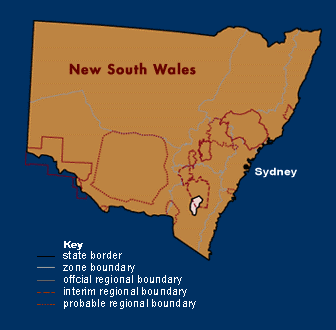New South Wales
Introduction
 Given the population, size and diverse geography of New South Wales, one might expect it would play a far more important role in viticulture and winemaking than it in fact does. After all, more people live in Sydney than in the whole of South Australia, Western Australia and Tasmania put together, yet in 1996 its vineyards covered only 15 493 hectares out of a total of 77 681 hectares, producing about 21 per cent of the total Australian grape crush.
Given the population, size and diverse geography of New South Wales, one might expect it would play a far more important role in viticulture and winemaking than it in fact does. After all, more people live in Sydney than in the whole of South Australia, Western Australia and Tasmania put together, yet in 1996 its vineyards covered only 15 493 hectares out of a total of 77 681 hectares, producing about 21 per cent of the total Australian grape crush.
The reasons are partly historical, partly climatic and partly demographic. Not surprisingly, Australia's first vines were planted in New South Wales (on the Farm Cove foreshore, near the present-day Government House), the first commercial wine was made there, and the first wine exported to England - by Gregory Blaxland in 1823 - emanated from the banks of the Parramatta River near what is now the industrial suburb of Ermington.
The centre of viticultural activity soon shifted to the Hunter Valley and remained there for a century. But neither the Hunter nor any other part of New South Wales experienced a gold rush remotely like that of Victoria, nor did it receive a nineteenthcentury influx of Silesian settlers with grape growing in their blood - as did South Australia - which enabled these States, first Victoria, then South Australia, to establish wine industries of significantly greater size and importance.
It took the advent of irrigation (in 1914) and two successive waves of Italian immigrants, one after the First World War, the next after the Second World War, to establish the Riverina and Sunraysia areas along the Murrumbidgee and Murray rivers.
The Riverina was to become the most prolific wine-producing area in the State in the aftermath of the Second World War and the table wine boom of the 1960s. It is a highly efficient and economical producer of white wine in particular, much of it good cask quality. Like any similar region, it aspires to greater things, but really only achieves this with its botrytis-infected Semillon.
The Hunter Valley has always depended on its proximity to the Sydney and Newcastle markets; as tourism has flourished, the Hunter has blossomed, and its future is absolutely assured. It is by no means a natural winemaking region.
Indeed, with the notable exception of the higher-altitude slopes of the Great Dividing Range, most of New South Wales is too hot, too dry, too humid or too wet to be really suitable for grape growing. Modern fungicide sprays, an ever-increasing understanding of the physiology of the grapevine and modern winery technology (and in the case of the Riverland areas, irrigation) make grape growing and winemaking possible in almost any situation. But it is very much the case of the dog preaching: the wonder is not that it does it well, but that it does it at all.
Increasingly, wine regions will flourish if they have outstanding climatic and geographic (principally soil) advantages or if they are close to major markets or on high-volume tourist routes.
The coastal regions of New South Wales by and large dependon the local tourist market, but the rapidly spreading viticultural map of the 1990s along the western side of the Great Dividing Range bears testimony to its suitability for viticulture. There is now a virtually continuous web of regions stretching from Cowra and the Canberra district in the south to Mudgee in the north, although outposts either end (Tumbarumba in the south, Inverell 8000 in the north) show the map-making hasn't finished yet.
Elevation, rather than latitude, is the key to understanding the climate and the types and styles of wine which these regions produce. But as elevation increases, and the growing season climate moderates, so does the risk of frost (principally spring, but sometimes autumn) increase.
The signs of this expansion along the Great Dividing Range were there when the first edition of this book was written in 1990, and they were duly recorded, but I have to admit to being surprised at the pace and extent of the subsequent (and ongoing) development. Precisely how the regions will develop remains to be seen: will they follow the Cowra pattern, basically acting as contract growers to absentee wineries, or will they follow that of Orange, which in the twinkling of an eye has a number of small wineries in its confines? Either way, their future seems assured, the map set to expand.
